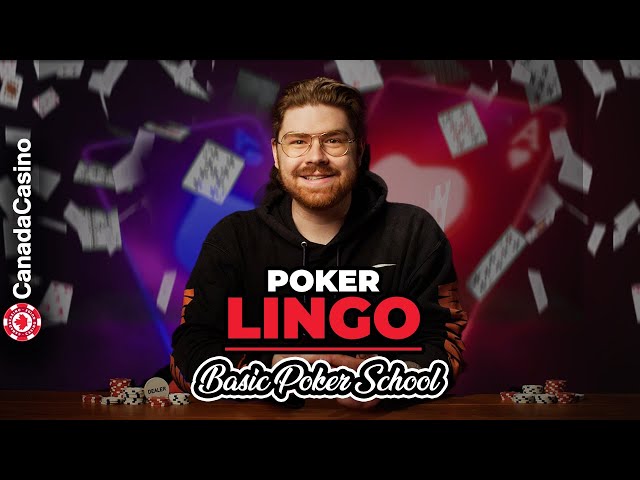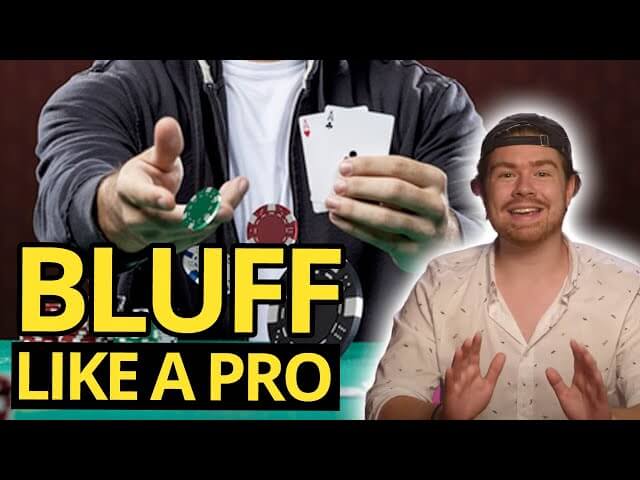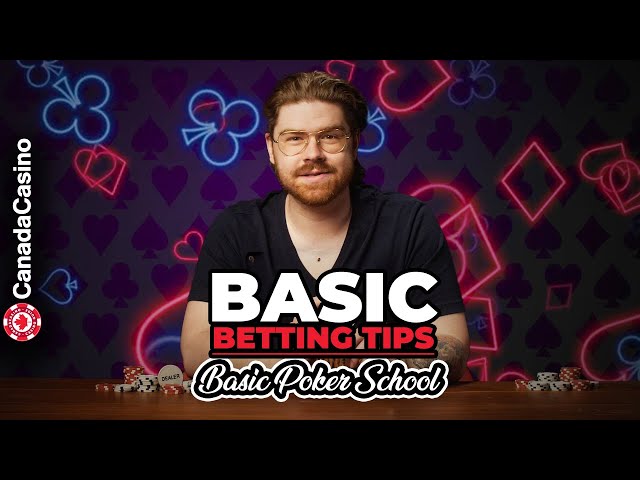Poker Strategy
Know When to Hold ‘Em!Poker strategy is a combination of human psychology, observational skill and game theory. It’s what enables seasoned players to win pot after pot without necessarily holding the best hand.
Play Poker at these Online Casinos in Canada

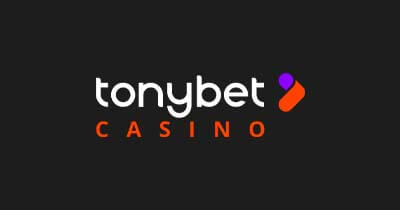




What will you learn from our Poker strategy guide?
From introducing the basics to advanced game theory, our Poker Strategy is a guide on all the fundamentals that every Canadian player can refer to. Mastering your Poker means you will be well equipped to play any type of poker game.
Learn which methods best fit your style of play and games of choice. Improve your odds and overall enjoyment with a Casino Poker Strategy that works for you.
First, make sure you understand poker terminology, at least the basics. You can watch our short video guide below on Poker Lingo:
Key Factors to remember before you start
Knowledge is power – getting a hold of the basics is crucial if you aim to be a good player at Poker. We are mentioning some key factors for you to understand better what needs to be learned
1. Get familiar with all the rules, odds and payouts
It’s difficult to win a game you don’t know how to play. Learning the game rules is the first step towards developing a poker strategy.
2. Choose Your Poker Variant smartly
The best online casinos world presents various poker variations are many, and it can get overwhelming, Look for a game that rings more familiar to you as a person.
3. Be realistic about your budget
How much can you afford to win or lose? As with any game in gambling, decide on a bankroll amount that you are comfortable losing.
Remember – seasoned players also set winnings goals as a basic practice.
4. Time is… well, money
We all have other things to do and need to plan the day accordingly. See how much time you will dedicate to playing and mastering your poker – and set a realistic limit that suits you as a person.
5. Which side are you on?
Poker is a table-based game with a seating arrangement that puts players in an early, middle or late position in relation to the dealer. An important part of poker strategy often includes your position at the table.
6. Learn the lingo
You want to know what the dealer is saying and what other players are talking about.
Well – poker has its own set of universal vocabulary. These are the words you need to know for the game.
| Vocab | Definition |
|---|---|
| Action | a player’s turn, or the amount in the pot |
| Ante | the minimum bet (or action) required to play the hand |
| All In | committing all your chips to a single hand |
| Bad Beat | bad luck |
| Burn | discarding the first card from the deck face down |
| Call | betting an amount equal to the previous bet made |
| Check | to not bet without folding |
| Draw | to play an average hand that could be improved |
| Flop | the first three cards dealt face up (community cards), the fourth is called the Turn, the fifth in the River |
| Hole Cards | cards dealt face down |
| Quads | four of a kind |
| Rags | a flop that doesn’t advantage any player |
| Tilt | playing recklessly |
| Trips | three of a kind |
Basic Poker Strategy
All poker strategies share a common denominator; self-control. Successful players are always patient, use aggression skillfully and fold far more often than they play. While learning the rules and hand values is relatively straightforward, the ability to play the odds and the opponents can take a lot of practice.
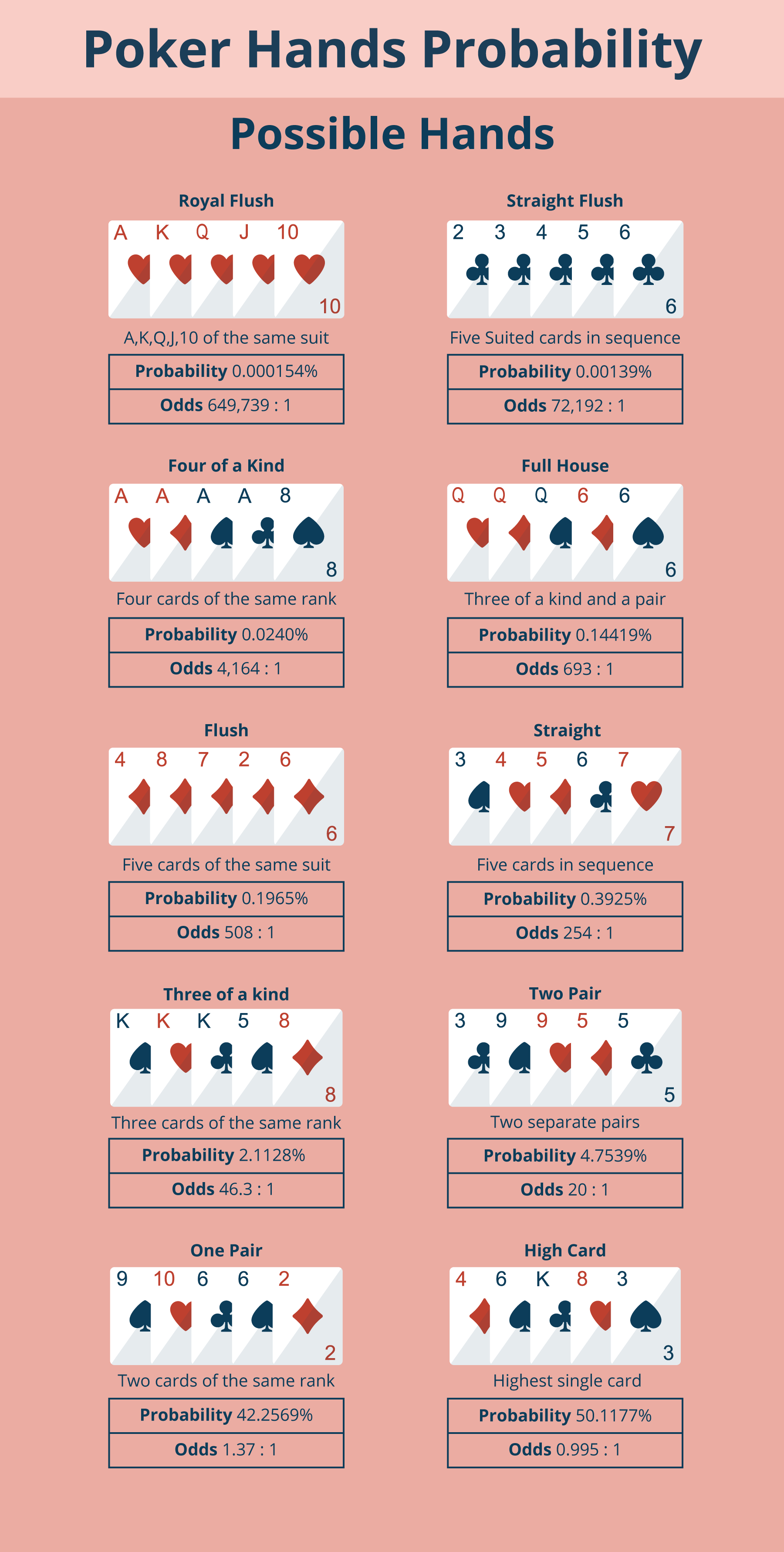
Which Poker playing styles are there?
Most poker players can be categorized within one of four categories of playing style; Tight-Aggressive, Loose-Aggressive, Tight-Passive or Loose-Passive.
Seasoned players adapt their style frequently, depending on the game’s progress and the opponents. Adopting a combination of styles makes a player less predictable – which is good.
1. Tight-Aggressive
A Tight player plays few hands and typically bets only with strong odds of winning.
2. Loose-Aggressive
A Loose player engages in a majority of hands, betting frequently with both strong and weak hands.
3. Aggressive
An aggressive player will often bet or raise more often than not.
4. Passive
A passive player will most often check or call and only infrequently raise.
When to raise your aggro up a notch?
Experienced poker players will tell you that aggression pays. If your hand looks strong, have the confidence to push for the pot by raising and challenging weaker hands to fold. If you are in a late position at the table and have heard the other players all check or fold, a raise is an easy way to take the existing pot.
When to call?
When choosing between raising, calling or folding, calling can be the most challenging.
When a player calls early, it often signals the table to a weak hand. It may have been better to fold. Players in the middle and late positions may see better opportunities to call, usually based on the opponents playing style, chip stack and relative table position.
Popular poker wisdom states that if a hand is not good enough to raise, it’s not good enough to call.
Understanding the Pot odds
The pot odds are the ratio between the value of the pot and the value of the bet you need to make.
So for example, if the pot is worth $100 and your bet is $10, the pot odds are 10%. Expressed another way, the pot odds represent the amount you will win for every dollar bet. Knowing this information and comparing it with your winning odds can inform playing your decisions.
Winning odds are straightforward to calculate and vary with the type of poker game being played, the number of players and the cards dealt.
The psychological aspect – playing the player
Poker is famously known as a game of observation. Every successful poker strategy addresses the importance of watching an opponent, and recognizing their playing style and habits.
These visual cues can be used to formulate winning strategies against them as the game progresses. Always be aware that seasoned opponents will often only show what they want to be seen. Is it a playing style, or camouflage?
Advanced Poker Strategy
For consistently winning players, an advanced poker strategy starts with the choice of the seat at the table and then evolves with every hand. The one constant is adapting your aggression style – creating and capitalizing on opportunities is how the pros win the big pots.
The different poker strategies are planned in accordance with human nature; the emotional and psychological tendencies of opponents; and how to read them.
What is bluffing?
Considered by poker players to be an art form, bluffing is a deception a player carries out by betting on a weak hand with the intention of provoking a stronger opponent to fold.
There are several factors that make up a successful bluff – such as the number of opponents and their playing styles, the bet size, and table position among others.
Bluffing is a subtle playing option that requires good game knowledge and observation skills.
Mastering it
As a poker beginner, it can be tempting to overuse the bluffing technique. These are the calculations you need to take into consideration when executing a successful bluff:
- Categorize opponents playing styles. Loose players are more inclined to call bluffs
- Consider your table image – If you are considered a tight player, your bluff will be taken more seriously
- Strike at the right time. Bluff earlier to show card confidence. Late bluffs appear desperate to seasoned players
- Consider well your bet size. How much is enough to induce an opponent to fold.
What is GTO
An acronym for Game Theory Optimal, GTO is considered the mathematically correct way to play poker against any opponent. As a poker strategy, GTO is made up of component parts and uses different strategies depending on the game variant being played.
How to Master GTO
These are key factors on the whats and ifs of GTO – if you ever want to master this technique – generally used by the more experienced players.
- GTO is a fairly complex topic that requires an optimal understanding of poker.
- GTO mathematics is not too difficult to learn with practice.
- This advanced strategy teaches players when and how to exploit opponents.
- GTO is ideally mastered through certified instruction.
Hand reading
Hand Reading is akin to Sherlock Holmes and the powers of deduction. Simply put, players apply logic to try and identify a range of hands that an opponent could be holding.
As the game progresses, an opponent’s actions often narrow down to the range of possible hands being held or eliminate those not being held.
By observing those actions, experienced players can fairly accurately deduce the type of hand they are up against. Tells – which will be explained below – will also add valuable information to that deduction.
Tells – speak about body language?
Tells describes the body language an opponent unconsciously displays. These could provide indicators of the type of cards held in hand.
Tells can manifest themselves in either voice, eye movement, degree of nervousness and other gestures that infer excitement or increased/decreased confidence. When compared with an opponent’s Levelling normal demeanour, Tells can partially reveal their decision-making process.
Levelling
As a Poker Strategy, Levelling might rival the gambits used by chess players.
A poker player attempts to predict an opponent’s next decision based on the information at hand, and a psychological evaluation.
After considering the cards, table positions, pots and betting decisions, taking into account Hand Readings and Tells, the player makes a decision based on an educated prediction.
Which Poker Strategy should you choose?
For beginners and pros alike, the best poker strategy is one that is built from a combination of strategies that matches the specific player’s skillset and fits their playing style.
After taking into consideration the game variation you wish to excel at, practice will help perfect a winning formula each player can call their own.
The best strategies for Poker to try when you’re new to casino
Are you a newbie to the world of poker? We’re shooting some valid pointers for you to read before indulging:
- Learn to identify opponents playing styles. Are they Tight-Aggressive? Loose-Passive? Choose your own playing style and adapt your game to fit within it.
- Aggressive play can land wins in poker games and respect but that aggression needs to be controlled. Place bets selectively and remember that opponents are trying to identify your playing style.
- Watch opponents closely to build observational skills. A perfect observation time is after folding and the pressure of the game is no longer a distraction.
- Adopt a strategy to compliment your skill level after thoroughly learning the rules and lingo of the game variation you’ve chosen.
Poker strategies to play if you’re a pro
- GTO – it’s the predominant poker strategy being employed by seasoned players. The need to understand the fundamentals of GTO is an utmost requirement if you aim to succesfully land wins.
- Levelling – as an expert player, using a levelling strategy should be your second nature. Since the beginning of times, experienced poker players that are fluent with the outcomes of poker have been using prediction based on game theory as a frequently go-to strategy.
Video poker strategy
- Based on five-card draw, players should learn the rules of Video poker and understand the pay-out tables of potential winnings.
- Pick the Video poker game with the highest paytable and/or that offers progressive jackpots.
- The best strategy for Video Poker is to use the time to your advantage. With no players or dealers to contend with, choose cards and make play decisions slowly.
- Keep an eye out for bonuses. Take advantage of special offers that extend playing time and increase the opportunities to win.
Poker tournaments strategy
- Change and adapt your playing style to the different stages of a poker tournament.
- Be patient. Mental endurance is key to winning through to the final stages.
- Bet selectively and bet aggressively.
- Know when to grab the best opportunities to eliminate opponents and acquire chips.
Poker strategies that got the most wins
In recent history, top-notch gamers have landed massive wins over their mastering of different tournament poker strategies.
We’re listing some of the world’s most known.
Daniel Negreanu – Canada – $42.2 million
Canadian player Negreanu is a massive icon in the world of poker, where through his uncanny way of reading his players, he has managed to land more than $42.2 million wins over the year.
Feder Holz – Germany – $21 million
Definitely one the most recent biggest poker winners, where during 2016 and 2017 he landed a total of $21 million by anticipating his player’s moves and changing different poker strategies according to the flow of the game.
Jennifer Harman – US – $15 million
American professional poker player Jennifer Harman won two bracelets for the World Series of Poker (WSOP) yearly event.
Jennifer is known to adopt different aggressive poker styles. She is known for her excellence at both reading her opponents and making them risk their stacks.
General beginner mistakes that are easy to avoid
- Playing too Loose. New players easily get caught up in the initial excitement of the game and can easily get carried away and lose their focus. For example, knowing when to fold a hand is a critical skill to learn and needs time and patience. Being selective about bets will also increase your winnings over the duration.
- Playing without a strategy. Poker is about a great deal more than luck. Adopting a poker strategy helps players consider the impact of each decision on their overall performance. Play to win the game, not just the hand.
- Using the same poker strategy repeatedly. A poker player who constantly meets opponents’ expectations will find it difficult to protect their bankroll. Every game is unique. Have a strategy ready that doesn’t transmit your playing style and that can easily the game on the day.
Make sure to check out our Poker School Series
We have even more poker content for any Canadian players looking to perfect the game! Check out one of our most recent videos on Betting Tips:

